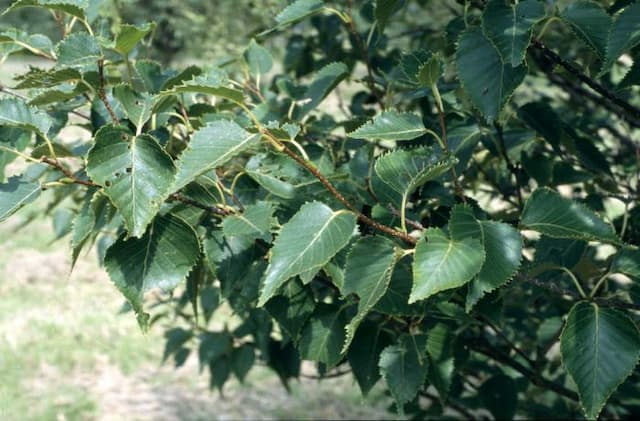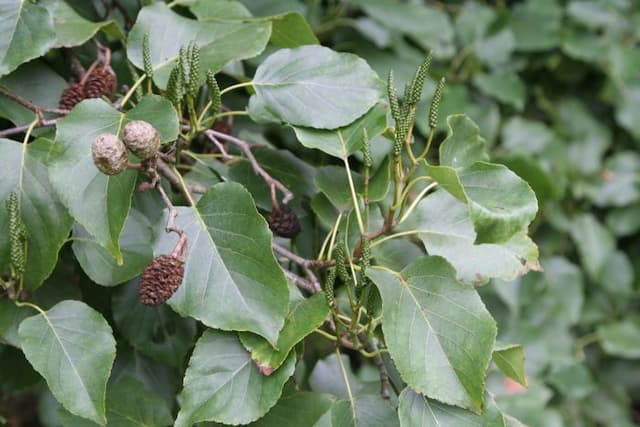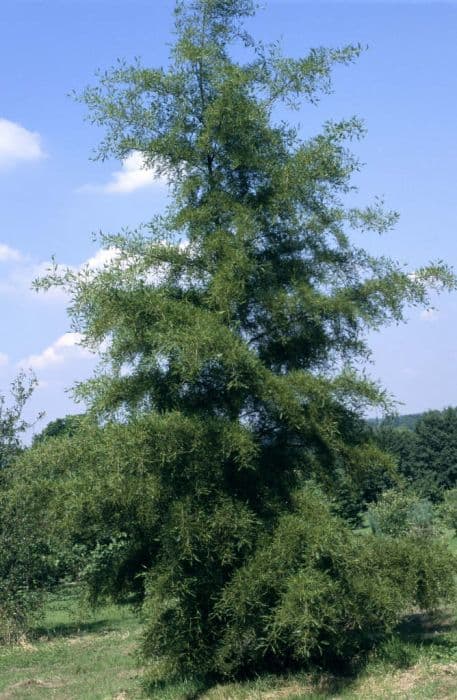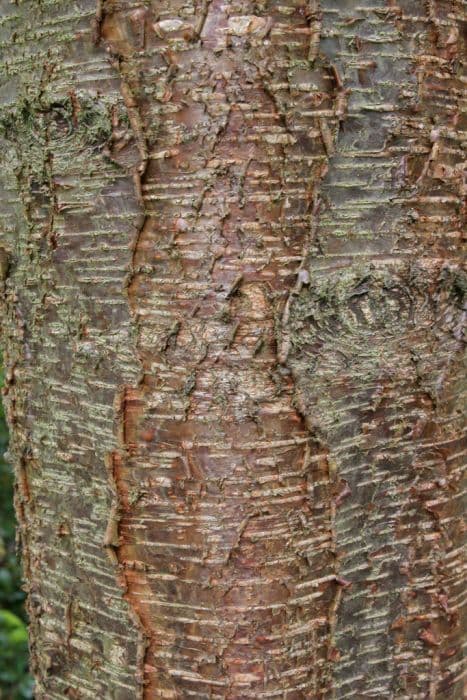Black birch 'Cully' Betula nigra 'Cully'

ABOUT
'Cully' a vigorous deciduous tree with creamy-brown, peeling bark and shiny dark green leaves turning yellow in autumn
About this plant
 Names
NamesFamily
Betulaceae.
Synonyms
Heritage River Birch, Cully Birch.
Common names
Betula nigra 'Cully'.
 Characteristics
CharacteristicsLife cycle
Perennials
Foliage type
Deciduous
Color of leaves
Green
Height
40 feet (12 meters)
Spread
25 feet (7.6 meters)
Plant type
Tree
Hardiness zones
4-9
Native area
North America
Benefits
 General Benefits
General Benefits- Aesthetic Appeal: Betula nigra 'Cully', commonly known as Heritage river birch, is known for its attractive peeling bark that displays a mix of colors including cream, orange, and salmon, which adds visual interest to any landscape.
- Shade Provider: Its canopy creates a substantial area of shade that can cool surroundings and provide relief from the summer sun.
- Erosion Control: The root system of the Heritage river birch helps stabilize the soil, which is beneficial for erosion control, particularly along riverbanks and other wet areas.
- Wildlife Habitat: This tree provides shelter and nesting sites for birds, and its seeds are a food source for various wildlife including birds and small mammals.
- Tolerance of Wet Conditions: Heritage river birch naturally grows in wet conditions, making it an ideal plant for areas with poor drainage or along bodies of water.
- Adaptability: It's adaptable to a range of soil types, pH levels, and environmental conditions, though it prefers moist, acidic soils.
- Pest Resistance: It has a better resistance to the bronze birch borer than other birches, reducing the need for pesticides.
- Fall Foliage: In the fall, its leaves turn a vibrant yellow, providing a striking seasonal display.
- Fast Growth: Heritage river birch is a fast-growing tree, quickly establishing itself and providing benefits shortly after planting.
- Urban Tolerance: It is tolerant of urban conditions like pollution and compacted soils, suitable for city landscaping.
 Medical Properties
Medical PropertiesThis plant is not used for medical purposes.
 Air-purifying Qualities
Air-purifying QualitiesThis plant is not specifically known for air purifying qualities.
 Other Uses
Other Uses- Betula nigra 'Cully', commonly known as Heritage River Birch, can be used for crafting furniture due to its attractive wood grain and durability.
- The bark of Heritage River Birch can be utilized in landscaping as a decorative element for garden paths and flower beds.
- In woodworking, the wood of Heritage River Birch is sometimes used for turned objects like bowls and vases because it holds fine details well.
- Artists may use the textured and patterned bark of this tree in collages or as a natural canvas for rustic art pieces.
- Due to its resistance to water, wood from the Heritage River Birch can be used to make wooden water features or ornamental bridges in gardens.
- The Heritage River Birch's branches can be used in floral arrangements and decorations, particularly due to their interesting bark and attractive form.
- This plant can serve as a natural playground material, where its limbs and trunks can be integrated into climbing structures or playhouses.
- The wood chips from pruned or fallen branches of the Heritage River Birch can be used as mulch to help retain moisture in garden beds.
- Fine-grained wood of the Heritage River Birch is suitable for crafting musical instruments such as woodwind instruments that require stable wood properties.
- Dried leaves and twigs from the Heritage River Birch can be used as a natural kindling for campfires or fireplaces, as they catch fire easily and burn hot.
Interesting Facts
 Feng Shui
Feng ShuiThe Heritage River Birch is not used in Feng Shui practice.
 Zodiac Sign Compitability
Zodiac Sign CompitabilityThe Heritage River Birch is not used in astrology practice.
 Plant Symbolism
Plant Symbolism- Adaptability: The Betula nigra 'Cully', also known as River Birch, is recognized for its adaptability to different environments, suggesting the quality of being able to thrive in changing circumstances.
- Growth and Renewal: As a prolific grower, the River Birch symbolizes new beginnings and the continual process of growth and renewal.
- Purification: The bark of the River Birch has been used historically for medicinal purposes, which symbolizes purification and healing.
- Protection: With its sturdy trunk and resilient nature, River Birch is often associated with protection and resilience against adversity.
- Hope: The light, peeling bark and green leaves that emerge each spring represent hope and the promise of what is yet to come.
 Water
WaterFor the River Birch tree, it is crucial to maintain a consistently moist soil, especially in the first few years after planting. In the initial growing season, water the tree deeply once or twice a week, depending on the weather conditions, soil type, and season. Once established, the tree will need less frequent watering, but during prolonged dry spells or extreme heat, increase watering to prevent stress. Typically, around 15-20 gallons per week for young trees, spaced out to allow soil to dry slightly between watering sessions would suffice, adjusting as necessary for mature trees and different environmental conditions.
 Light
LightThe River Birch thrives in full sun to partial shade. It is best to plant this tree where it can receive at least six hours of direct sunlight each day, with some afternoon shade in hotter climates to protect it. Avoid deeply shaded areas, as the River Birch requires adequate sunlight to grow well and maintain health.
 Temperature
TemperatureThe River Birch is hardy and can tolerate a wide range of temperatures, thriving in USDA Hardiness Zones 4 through 9. It can withstand winters with temperatures dipping as low as -30°F and tolerate summer highs up to around 90°F, but the ideal temperature range for optimal growth is between 50°F and 70°F.
 Pruning
PruningPruning the River Birch is important for maintaining tree health, shape, and removing any damaged or diseased branches. The best time for pruning is late fall to early spring when the tree is dormant. Annual pruning is advisable to remove any problematic growth and to encourage a strong, attractive structure. Ensure clean cuts and avoid leaving stubs to promote proper healing.
 Cleaning
CleaningAs needed
 Soil
SoilThe best soil mix for River Birch should be rich, acidic, and well-draining with a pH of 4.0 to 6.5. Incorporate peat moss and compost for organic content, ensuring the soil remains moist but not waterlogged.
 Repotting
RepottingRiver Birch trees, being large landscape plants, are not commonly repotted. Once planted outdoors, they do not require repotting but might need occasional transplanting for spacing as they grow.
 Humidity & Misting
Humidity & MistingRiver Birch trees thrive in average to high humidity levels. While specific humidity percentages are not critical for this outdoor plant, maintaining a good moisture level in the air and soil will promote its health.
 Suitable locations
Suitable locationsIndoor
Grow River Birch indoors with bright light, moist soil, and room to grow.
Outdoor
Plant River Birch in moist soil, full sun to part shade, and mulch well.
Hardiness zone
4-9 USDA
 Life cycle
Life cycleThe life cycle of the Betula nigra 'Cully', commonly known as the Heritage River Birch, begins with seed germination, which occurs in ideal conditions of moisture and temperature, typically on saturated ground. The seedlings establish rapidly and enter a juvenile growth phase, characterized by a fast growth rate and the development of distinctive peeling bark. As the tree reaches maturity, it develops a spreading canopy with typically triangular-shaped leaves and begins to produce catkins, which are the male and female flowers of the birch. Pollination occurs mainly through wind dispersal, leading to seed production and dispersal, allowing for the continuation of the cycle. As a mature tree, the Heritage River Birch can produce thousands of seeds annually, and under suitable environmental conditions, the process of germination to seed production can continue for several decades. The plant may eventually enter senescence, signified by a decline in growth and reproductive capacity, before dying naturally or being affected by external factors like disease or environmental changes.
 Propogation
PropogationPropogation time
Late winter
Propogation: River Birch, known botanically as Betula nigra 'Cully', is commonly propagated through semi-hardwood cuttings. The best time for taking semi-hardwood cuttings is in the late summer to early autumn. A cutting is typically a branch segment of the current year's growth that has started to mature but is not yet fully hardened. It should be about 4 to 6 inches long with several leaves at the top. The lower leaves are removed, and the bottom end of the cutting is dipped in a rooting hormone to encourage root growth. It is then planted in a mix of sand and peat or a soilless media to provide good drainage and aeration. The cuttings need a consistently moist environment and should be kept under intermittent mist or a humidity dome to prevent drying out. With proper care, roots will develop, after which the new plants can be transitioned to individual pots or to outdoor conditions, depending on the climate and time of year.









